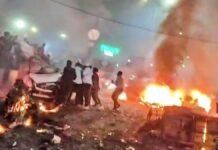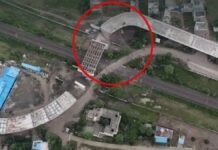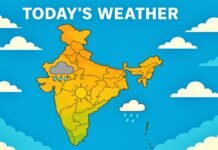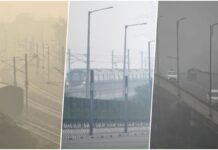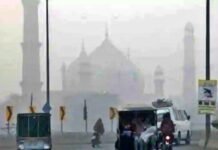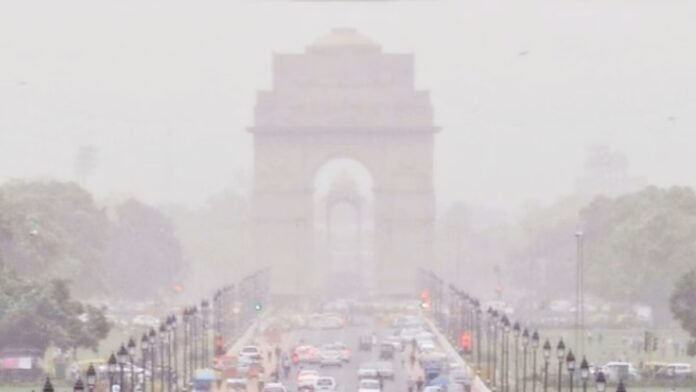
Key Points
- Delhi’s average AQI reaches 345 (‘very poor’ category) on Diwali day, up from 326 on Sunday
- 34 out of 38 monitoring stations record pollution in ‘red zone’ as of 4 PM on October 21, 2025
- Four stations enter ‘severe’ category with AQI above 400: Wazirpur (423), Dwarka (417), Ashok Vihar (404), Anand Vihar (404)
- Transportation contributes 15.6% to pollution; industrial and other sources account for 23.3%
- Air quality forecast to worsen to ‘severe’ category on Tuesday and Wednesday
- CAQM implements GRAP Stage-2 restrictions across Delhi-NCR
- Supreme Court permitted green crackers from 8-10 PM on Diwali despite air quality concerns
New Delhi: The national capital woke up to hazardous air on Diwali morning, October 21, 2025, as pollution levels surged across the city despite restrictions on conventional firecrackers. By 4 PM, Delhi’s 24-hour average Air Quality Index (AQI) climbed to 345, firmly in the ‘very poor’ category, marking a deterioration from Sunday’s reading of 326 and confirming predictions of post-festival air quality crisis.
Widespread Pollution Across Monitoring Network
Real-time data from the Central Pollution Control Board (CPCB)’s Sameer app painted a grim picture of Delhi’s air quality landscape. Of the 38 functional monitoring stations spread across the capital, 34 stations recorded pollution levels in the dangerous ‘red zone,’ indicating ‘very poor’ to ‘severe’ air quality conditions affecting millions of residents.
The geographic spread of poor air quality demonstrates that no area of Delhi escaped the pollution surge. From residential neighborhoods to commercial hubs, the toxic air blanketed the entire city, with visibility reduced and a thick haze hanging over major thoroughfares.
Four Stations Enter ‘Severe’ Territory
Most alarming were readings from four monitoring stations that crossed into the ‘severe’ category with AQI levels exceeding 400. Wazirpur in north Delhi recorded the highest AQI at 423, followed by Dwarka in southwest Delhi at 417. Both Ashok Vihar in northwest Delhi and Anand Vihar in east Delhi registered AQI of 404.
These ‘severe’ category readings indicate air quality so poor that it affects healthy people and seriously impacts those with existing respiratory conditions. Health advisories typically recommend that residents avoid all outdoor physical activity when AQI enters this range.
The concentration of severely polluted stations in diverse geographical areas from industrial Wazirpur to residential Dwarka—suggests multiple pollution sources contributing simultaneously to the crisis rather than localized factors.
Thirty Stations Report ‘Very Poor’ Air
Nearly 30 monitoring stations across Delhi reported AQI in the ‘very poor’ category, with readings above 300 but below the 400 threshold for ‘severe’ classification. This category indicates that prolonged exposure can cause respiratory illness in the general population and aggravate existing heart and lung diseases.
Data collected at noon showed 31 out of 38 stations recording ‘very poor’ air quality, while three had already entered the ‘severe’ category. The afternoon progression demonstrates how pollution accumulated throughout the day as festival activities intensified.
Areas reporting ‘very poor’ air quality included major residential zones, commercial districts, and institutional areas, confirming the citywide nature of the pollution emergency. No monitoring station recorded air quality better than the ‘poor’ category on Diwali day.
Understanding the AQI Scale
The Air Quality Index operates on a standardized scale that categorizes pollution levels:
- 0-50: Good (minimal health impact)
- 51-100: Satisfactory (minor breathing discomfort for sensitive individuals)
- 101-200: Moderate (breathing discomfort for people with lung disease)
- 201-300: Poor (breathing discomfort for most people on prolonged exposure)
- 301-400: Very Poor (respiratory illness on prolonged exposure)
- 401-500: Severe (affects healthy people; serious impact on those with existing diseases)
Delhi’s current readings place most of the city in the second-worst category, with pockets entering the worst classification. These levels pose serious health risks, particularly for children, elderly residents, and those with pre-existing cardiovascular or respiratory conditions.
Forecast: Worsening Conditions Ahead
Environmental agencies issued alerts warning that Delhi’s air quality is expected to deteriorate further, potentially reaching the ‘severe’ category across most monitoring stations on Tuesday, October 22, and Wednesday, October 23. This grim forecast accounts for several factors including meteorological conditions, continued burning of firecrackers in NCR areas, and residual pollutants settling in the atmosphere.
The predicted worsening comes despite firecracker restrictions, suggesting that other pollution sources including vehicular emissions, industrial activity, and seasonal factors like stubble burning in neighboring states continue contributing significantly to the toxic air mix.
Meteorologists note that reduced wind speeds and lower temperatures typical of late October create unfavorable dispersion conditions, trapping pollutants close to ground level and preventing natural cleansing of the air.
Pollution Source Analysis
Decision Support System (DSS) data provided detailed attribution of pollution sources contributing to Delhi’s toxic air on Diwali. Transportation emissions accounted for 15.6% of the total pollution load, reflecting continued vehicular traffic despite festival holidays when some commuter traffic typically decreases.
More significantly, industries and other sources contributed 23.3% to air pollution levels. This substantial contribution from non-firecracker sources explains why pollution levels remained elevated even before evening festivities began and suggests that addressing Delhi’s air quality crisis requires comprehensive interventions beyond seasonal firecracker bans.
The remaining pollution sources include construction dust, biomass burning, waste burning, and regional pollutants transported from neighboring states. The cumulative effect of these multiple sources creates the toxic air blanket enveloping the capital.
GRAP Stage-2 Restrictions Implemented
In anticipation of deteriorating air quality, the Commission for Air Quality Management (CAQM) implemented Stage-2 restrictions under the Graded Response Action Plan (GRAP) across the Delhi-NCR region before Diwali. These intermediate-level restrictions aim to curb pollution through targeted interventions.
GRAP Stage-2 measures include:
- Enhanced mechanical and vacuum sweeping of roads
- Water sprinkling on major traffic corridors
- Strict enforcement against garbage and biomass burning
- Intensified inspections at pollution hotspots
- Enhanced parking fees to discourage private vehicle use
- Increased public transport services
- Restrictions on diesel generator use except for emergency services
Despite these measures, pollution levels continued rising, raising questions about enforcement effectiveness and the adequacy of current intervention strategies. Environmental activists argue that more aggressive actions, including temporary industrial shutdowns and emergency vehicle restrictions, may be necessary when air quality enters ‘severe’ territory.
Supreme Court’s Green Cracker Permission
The Supreme Court of India issued an order on October 15, 2025, permitting the sale and use of so-called “green crackers” in Delhi-NCR, subject to specific time restrictions. This ruling attempted to balance cultural traditions associated with Diwali celebrations against public health concerns related to air pollution.
Under the court’s directive, bursting of green crackers was permitted during two time windows:
- 6:00 AM to 7:00 PM on the day before Diwali and on Diwali day
- 8:00 PM to 10:00 PM on Diwali night
Green crackers, developed by the Council of Scientific and Industrial Research (CSIR), are designed to produce 30% less particulate matter compared to conventional firecrackers and eliminate certain toxic chemicals. However, their real-world effectiveness remains debated, with environmental groups questioning whether meaningful reductions in pollution occur.
The court’s decision represented a compromise position after years of complete firecracker bans that proved difficult to enforce and generated significant public resistance. Critics argue that any firecracker burning contributes to pollution spikes, while supporters maintain that limited, regulated use of reduced-emission alternatives respects cultural practices while minimizing environmental harm.
Ground Reality: Enforcement Challenges
Despite the restricted time windows and specifications for only green crackers, ground reports suggest widespread violations occurred across Delhi-NCR. Conventional firecrackers were openly sold and burst throughout the region, with enforcement agencies overwhelmed by the scale of non-compliance.
Police and pollution control board officials reported numerous complaints about illegal firecracker use outside permitted hours and sale of banned conventional crackers. However, limited personnel and the distributed nature of violations made comprehensive enforcement practically impossible.
The widespread flouting of restrictions contributed to the severe pollution spike, though environmental experts note that even perfect compliance would not have prevented significant air quality deterioration given Delhi’s baseline pollution levels and unfavorable meteorological conditions.
Public Health Implications
The toxic air quality poses immediate and long-term health risks for Delhi’s 20+ million residents. Short-term exposure to ‘very poor’ and ‘severe’ air quality causes respiratory irritation, breathing difficulties, coughing, and aggravation of asthma and other lung diseases.
Vulnerable populations including children, pregnant women, elderly residents, and those with cardiovascular or respiratory conditions face particularly high risks. Doctors across Delhi reported increased emergency room visits for breathing difficulties and asthma attacks following Diwali evening.
Long-term exposure to such pollution levels contributes to chronic respiratory diseases, cardiovascular problems, reduced lung function in children, and increased cancer risks. Studies have shown that Delhi residents lose years of life expectancy due to sustained exposure to hazardous air quality.
Comparative Context
Delhi’s Diwali pollution crisis has become an annual occurrence, with similar patterns observed in recent years. However, the 2025 readings represent a continuation of concerning trends despite various policy interventions attempted over the past decade.
Compared to previous years, enforcement of firecracker restrictions has improved marginally, but behavioral change among the population remains limited. The cultural significance of fireworks during Diwali creates resistance to restrictions, while lack of immediate visible health consequences reduces urgency for voluntary compliance.
Regional cooperation on pollution control remains inadequate, with neighboring states’ contributions through stubble burning and industrial emissions continuing unchecked. The National Capital Region’s air quality management requires coordinated action across state boundaries that has proven politically and administratively challenging to implement.
Looking Ahead
As Delhi braces for continued poor air quality through the coming days, authorities face pressure to implement more aggressive interventions under higher GRAP stages. Stage-3 and Stage-4 measures include construction bans, school closures, work-from-home mandates, and restrictions on private vehicle use.
The recurring nature of Delhi’s air quality crisis highlights the need for year-round pollution control measures rather than seasonal emergency responses. Systemic changes in transportation, energy, construction practices, and waste management are necessary to address the structural causes of poor air quality.
Meanwhile, residents are advised to remain indoors with air purifiers, wear N95 masks when venturing outside, avoid strenuous outdoor activities, and seek medical attention for respiratory symptoms. For millions without access to such protective measures, the toxic air represents an unavoidable health hazard that underscores the environmental justice dimensions of Delhi’s pollution emergency.




